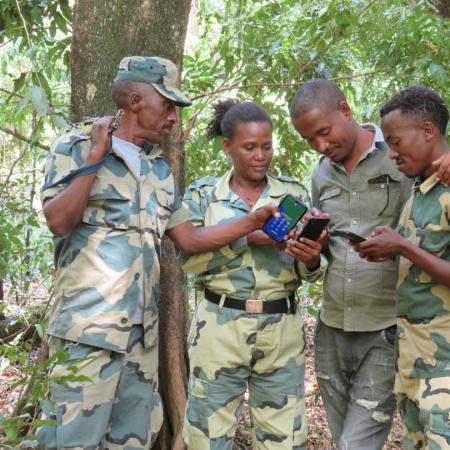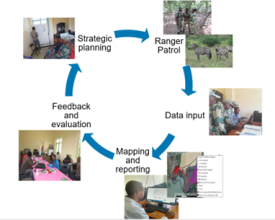
SMART: A digital monitoring system for effective management of protected areas

Nech Sar National Park is one of Ethiopia's oldest protected areas, conserved for its diverse flora, fauna, and unique landscapes. However, unsustainable use of resources poses a significant threat to the park. The absence of standardised protocols and systems for recording illegal human activities and threats hinders the effective use and management of the park. The poor enforcement of planning, decision-making and resource allocation processes further fuels the issue.
To address these challenges, the BMZ-funded and GIZ-implemented Biodiversity and Forestry Programme introduced the Spatial Monitoring and Reporting Tool (SMART). SMART is a tool that simplifies and enhances data collection, analysis, and reporting in protected area management. It supports various conservation activities such as protection of biodiversity, law enforcement, natural resources utilisation, and tourism management. With its easy-to-use features, SMART offers powerful options for effective management and protection of natural resources.
Context
Challenges addressed
Environmental challenges
Unsustainable use of resources is one of the threats that the park is experiencing. The park has long been used for the extraction of fuelwood and charcoal to support subsistence livelihoods. This has resulted in destruction of ecosystems and loss of biodiversity.
Social challenges
The traditional law enforcement monitoring and data recording system was paper based, resulting in time consuming, costly data collection and analysis which contained of a lot of errors and inconsistencies. Moreover, local communities experienced livelihood disruptions, health implications, and community instability due to unsustainable and ineffective management of protected areas.
Economic challenges
With the growing number of unemployed people around the national park, dependence on the park resources was of great concern. Hundreds of firewood bundles were extracted from the forest daily, charcoal production and unsustainable fishing were widely carried out for commercial purposes.
Location
Process
Summary of the process
SMART-based strategic planning sets the foundation for effective operations by establishing goals, objectives, and actionable plans. It defines the direction and targets to be achieved.
SMART-based patrolling and field data collection are then implemented as part of the strategic plan. Patrolling activities are carried out with a focus on specific areas identified through strategic planning. During patrols, field data is collected, which includes observations, incidents, and other relevant information.
SMART-based monitoring and reporting utilises the field data collected to monitor progress, measure the impact of implemented actions, and evaluate the effectiveness of the strategic plan. This information is reported and analysed to take the appropriate action, identify areas of improvement and make informed decisions for continuous adaptations of plans.
In summary, SMART-based strategic planning serves as the guiding framework, while SMART-based patrolling and field data collection provide the necessary information for monitoring and reporting, which in turn informs future strategic planning iterations. The three components work together in a cyclical process, ensuring adaptive management and continuous improvement.
Building Blocks
SMART-based strategic planning
SMART-based strategic planning is an approach that involves setting specific, measurable, achievable, relevant, and time-bound goals to guide the development and implementation of strategies. The SMART platform allows the park administration to improve the management effectiveness in terms of reducing illegal activities and improving patrol teams’ efforts and effectiveness of resources allocation.
SMART-based strategic planning is used to:
- Set numeric and spatial targets - SMART focal persons in the park, in collaboration with the park management, set numeric and spatial targets for all patrol teams and prepare monthly deployment plans for both terrestrial and aquatic parts of the park. The targets help in setting clear and measurable benchmarks to the goals and objectives of patrol teams in protected areas. It makes tracking progress and measuring the impact of the strategic planning and law enforcement efforts easier.
- Create adaptive management mechanisms - Adaptive management mechanisms are useful for continuously creating a law enforcement plan, acting on the plan, measuring the impact of the plan, and creating a new improved plan based on that information. By learning from outcomes and revising, adaptive mechanisms help to address uncertainties and promote effective management strategies in dynamic systems.
Enabling factors
A SMART operations committee was established to implement effective adaptive management mechanisms that enable the continuous creation, execution, measurement, and improvement of plans. The committee made the strategic planning possible by guiding the operation, reporting, budgeting, and planning of SMART patrols, ensuring their logistical and financial sustainability, managing internal department coordination, and coordinating with other law enforcement agencies.
Lesson learned
The key lesson learned is that successful implementation and operationalization of SMART is highly dependent on the commitment and willingness of national park managers to change management systems and practices. The introduction of new systems like SMART needs to be done gradually, to allow enough time for adoption by the users and ensure that the data collected is accurate and consistent. Proper planning and training are required to make the implementation and use of the platform as smooth and simple as possible.
SMART-based patrolling and field data collection
SMART-based patrolling and field data collection is a methodology that utilizes the SMART framework to effectively guide and optimize patrolling activities and field data collection processes. The collection of SMART-data is automated by CyberTracker, an application that captures data and provides visualization capabilities. A patrol-configurable CyberTracker plug-in was implemented within the SMART-database to document illegal activities within national parks. It is specifically tailored for use at Nech Sar National Park, with data collection formats structured around threats, wildlife, and habitats. The data model and collection protocols focus on gathering only the necessary data for effective patrol management and management indicators.
SMART-based patrolling and field data collection has simplified and streamlined workflows and increased data accuracy and consistency. The platform also made it easy for the management to record their daily activities and helped to reduce workload on patrol teams by reducing time spent on filing the data collected by 50%. Detailed and standardised protocols of collection, storage, management, and processing of data on SMART support law enforcement and proper management of the national park and its resources.
Enabling factors
All 54 frontline rangers were trained on SMART-based patrolling, data collection protocols and field data collection using the SMART mobile application. Rangers’ SMART data collection protocols and step-by-step procedure pocket booklets (laminated with waterproof materials) were developed and used by the management staff (rangers) during field data collection.
Additionally, to fill gaps on recording field data during patrol mission, continuous orientation was provided to patrol ranger heads, patrol mission deployment heads and selected rangers.
Lesson learned
The lesson learned from the implementation of SMART-based patrolling and field data collection is that simplifying the language used in data models of the platform is necessary to enhance accuracy of data collection. Not all rangers are familiar with scientific names and the terminology of ecology. For this reason, the previous SMART data model that had scientific species names made it difficult for rangers to identify them. However, upon simplifying to common names, an improvement in data collection was observed.
SMART-based monitoring and reporting
SMART is used as a monitoring database for systematic archiving of data, documentation, analysis and data processing. It is also used for the preparation and evaluation of patrol reports and feedback sessions with rangers. A SMART operations room was established at the park and is used for interpreting monthly patrol reports, preparing feedback for patrol teams, developing adaptive patrol strategies, and planning deployment of patrol teams by the SMART committee.
SMART provides an automated platform for making data entry, analysis, and report generation very easy. It reduces time of analysis and reporting from more than 12 days to 2-3 hours by using the SMART database manager. It also enables reporting of the full spectrum of work the park management does. SMART generates a variety of customisable, yet standardised reports and charts, for example of threat indicators, patrol effort statistics and individual ranger performance summaries.
Enabling factors
To enhance park experts’ skill and capacity to analyse, generate reports and interpret patrol and monitoring data, eight experts took capacity building trainings.
In addition, the SMART operation committee plays various roles including guiding the operations, overseeing reporting, budgeting, and planning of SMART patrols. They also ensure the logistical and financial sustainability of these patrols, manage internal department coordination, and facilitate coordination with other law enforcement agencies.
Lesson learned
The main takeaway is that effective training in SMART-based adaptive patrol management, monitoring, deployment mechanisms, and systems is essential for both management officials and members of the SMART operation team. Furthermore, conducting debriefing sessions and providing consistent feedback to patrol teams are critical components for strategic patrol planning, deployment and reporting.
Impacts
Environmental impacts
SMART data collection and analysis has allowed national park managers to track and assess illegal activities in the park and to develop strategies to combat them. The destruction of natural resources and illegal activities such as charcoal production, wood logging, fishing, and hunting have decreased over time.
Social impacts
The preservation of cultural identity among local communities and the sense of belonging and connection that individuals have to their heritage is enhanced through the protection of the park. Additionally, the overall well-being of local communities is guaranteed through the conservation of the park.
Economic impacts
SMART deployment has resulted in a significant increase in data collection efficiency, as it has reduced data collection time by 50%. The data-driven patrol deployment planning and resource allocation have led to reduction in regular patrolling by 35%, while increasing strategic and joint patrolling missions. This streamlined approach has allowed time and money to be allocated more effectively and increased data accuracy.
Local communities living near protected areas and forests experience economic benefits from the improved management and conservation. Well-managed areas attract visitors who engage in ecotourism activities, which in turn benefits the surrounding communities.
Beneficiaries
National park management and staff,
SMART operation committee,
Departmental wardens,
Patrol teams,
Educational Institutions (Wondo Genet College),
Local authorities(decision-makers) and
Local communities.
Sustainable Development Goals
Story

Bayush Terefe, a 36-year-old ranger in Nech Sar National Park, has been responsible for leading a team of 5-7 rangers for daily patrolling to monitor illegal activities, track and intercept poachers, and address human-wildlife conflict. However, the effectiveness of the patrol team was poor due to irregular and disorganized patrolling systems, with no accountability mechanisms or performance evaluation systems in place.
In response, Bayush and her colleagues received training on advanced patrolling, law enforcement, and SMART-based patrolling and data collection protocols. Despite initial resistance to the platform, Bayush and her team soon realized the benefits of SMART-based patrolling and monitoring, leading to increased motivation and performance. With the new system in place, it takes just a minute to record multiple observations simultaneously, leading to a boost in daily patrolling efficiency.
Bayush compared the scenario before and after the introduction of SMART-based patrolling. “The SMART based patrolling and monitoring system has multiple benefits. For instance, before SMART based patrolling system, I and my colleagues spent a lot of time and efforts for recording encountered illegal activities and ecological indicators on paper formats, but now it takes just a minute to record multiple observations simultaneously and we are able to perform diverse tasks during patrolling and monitoring”.
Additionally, the implementation of a SMART-based ranger evaluation system has allowed for accurate assessment of patrol team and individual ranger efforts. The annual performance evaluation, awards, and promotion system for rangers shifted from the traditional subjective judgement to performance-based metrics that are verified through SMART.
Bayush further explained how the SMART-based ranger evaluation system has boosted the patrol rangers' motivation and performance. She mentioned that receiving proper recognition and acknowledgment for what they have accomplished and the efforts they put in place during their patrol missions has been one of the major motivations for all patrol rangers to continue to perform their duties to the best of their abilities.
The introduction of SMART has greatly enhanced the efficiency of Bayush and her team by reducing the time and effort required for recording observations. Moreover, it keeps them motivated by accurately measuring the continuous effort and results of the patrol teams in managing the park.




